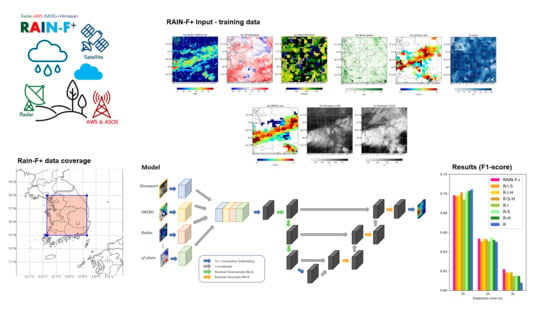RAIN-F+: The Data-Driven Precipitation Prediction Model for Integrated Weather Observations
Abstract
:1. Introduction
2. Data Descriptions
- The operational radar system over the Korean Peninsula;
- The surface weather observations provided by Korea Meteorological Administration (KMA);
- The version 6 of IMERG products from the National Aeronautics and Space Administration (NASA);
- The Himawari-8 satellite from Japan Meteorological Agency (JMA).
2.1. Radar Observations
2.2. AWS and ASOS Observations
2.3. IMERG Products
2.4. Himawari Products
2.5. RAIN-F+ Overviews
3. Methodology
3.1. Model Architecture
3.2. Construction of Training and Test Dataset
3.3. Model Evaluation
4. Results and Discussion
5. Discussion and Future Work
Author Contributions
Funding
Institutional Review Board Statement
Informed Consent Statement
Data Availability Statement
Acknowledgments
Conflicts of Interest
References
- Xingjian, S.; Chen, Z.; Wang, H.; Yeung, D.Y.; Wong, W.K.; Woo, W.C. Convolutional LSTM network: A machine learning approach for precipitation nowcasting. In Proceedings of the Advances in Neural Information Processing Systems, Montreal, QC, USA, 7–12 December 2015; pp. 802–810. [Google Scholar]
- Chandrasekar, R.; Balaji, C. Sensitivity of tropical cyclone Jal simulations to physics parameterizations. J. Earth Syst. Sci. 2012, 121, 923–946. [Google Scholar] [CrossRef] [Green Version]
- Pulkkinen, S.; Chandrasekar, V.; Harri, A.M. Nowcasting of precipitation in the high-resolution Dallas–Fort Worth (DFW) urban radar remote sensing network. IEEE J. Sel. Top. Appl. Earth Obs. Remote Sens. 2018, 11, 2773–2787. [Google Scholar] [CrossRef]
- Pulkkinen, S.; Chandrasekar, V.; Harri, A.M. Fully spectral method for radar-based precipitation nowcasting. IEEE J. Sel. Top. Appl. Earth Obs. Remote Sens. 2019, 12, 1369–1382. [Google Scholar] [CrossRef]
- Pulkkinen, S.; Chandrasekar, V.; Harri, A.M. Stochastic spectral method for radar-based probabilistic precipitation nowcasting. J. Atmos. Ocean. Technol. 2019, 36, 971–985. [Google Scholar] [CrossRef]
- Pulkkinen, S.; Chandrasekar, V.; von Lerber, A.; Harri, A.M. Nowcasting of convective rainfall using volumetric radar observations. IEEE Trans. Geosci. Remote Sens. 2020, 58, 7845–7859. [Google Scholar] [CrossRef]
- Radhakrishnan, C.; Chandrasekar, V. CASA Prediction System over Dallas–Fort Worth Urban Network: Blending of Nowcasting and High-Resolution Numerical Weather Prediction Model. J. Atmos. Ocean. Technol. 2020, 37, 211–228. [Google Scholar] [CrossRef]
- Sønderby, C.K.; Espeholt, L.; Heek, J.; Dehghani, M.; Oliver, A.; Salimans, T.; Agrawal, S.; Hickey, J.; Kalchbrenner, N. Metnet: A neural weather model for precipitation forecasting. arXiv 2020, arXiv:2003.12140. [Google Scholar]
- Trebing, K.; Staǹczyk, T.; Mehrkanoon, S. SmaAt-UNet: Precipitation nowcasting using a small attention-UNet architecture. Pattern Recognit. Lett. 2021, 145, 178–186. [Google Scholar] [CrossRef]
- Kumar, A.; Islam, T.; Sekimoto, Y.; Mattmann, C.; Wilson, B. Convcast: An embedded convolutional LSTM based architecture for precipitation nowcasting using satellite data. PLoS ONE 2020, 15, e0230114. [Google Scholar] [CrossRef]
- Ayzel, G.; Scheffer, T.; Heistermann, M. RainNet v1. 0: A convolutional neural network for radar-based precipitation nowcasting. Geosci. Model Dev. 2020, 13, 2631–2644. [Google Scholar] [CrossRef]
- de Witt, C.S.; Tong, C.; Zantedeschi, V.; De Martini, D.; Kalaitzis, A.; Chantry, M.; Watson-Parris, D.; Bilinski, P. RainBench: Towards Data-Driven Global Precipitation Forecasting from Satellite Imagery. In Proceedings of the AAAI Conference on Artificial Intelligence, Virtual Event, online, 2–9 February 2021; Volume 35, pp. 14902–14910. [Google Scholar]
- Hong, D.; Gao, L.; Yokoya, N.; Yao, J.; Chanussot, J.; Du, Q.; Zhang, B. More diverse means better: Multimodal deep learning meets remote-sensing imagery classification. IEEE Trans. Geosci. Remote Sens. 2020, 59, 4340–4354. [Google Scholar] [CrossRef]
- Baltrušaitis, T.; Ahuja, C.; Morency, L.P. Multimodal machine learning: A survey and taxonomy. IEEE Trans. Pattern Anal. Mach. Intell. 2018, 41, 423–443. [Google Scholar] [CrossRef] [PubMed] [Green Version]
- Zhang, Q.; Yang, L.T.; Chen, Z.; Li, P. A survey on deep learning for big data. Inf. Fusion 2018, 42, 146–157. [Google Scholar] [CrossRef]
- Chu, X.; He, J.; Song, H.; Qi, Y.; Sun, Y.; Bai, W.; Li, W.; Wu, Q. Multimodal Deep Learning for Heterogeneous GNSS-R Data Fusion and Ocean Wind Speed Retrieval. IEEE J. Sel. Top. Appl. Earth Obs. Remote Sens. 2020, 13, 5971–5981. [Google Scholar] [CrossRef]
- Zhou, K.; Zheng, Y.; Dong, W.; Wang, T. A deep learning network for cloud-to-ground lightning nowcasting with multisource data. J. Atmos. Ocean. Technol. 2020, 37, 927–942. [Google Scholar] [CrossRef]
- Miao, K.; Wang, W.; Hu, R.; Zhang, L.; Zhang, Y.; Wang, X.; Nian, F. Multimodal Semisupervised Deep Graph Learning for Automatic Precipitation Nowcasting. Math. Probl. Eng. 2020, 2020. [Google Scholar] [CrossRef]
- Li, G.; Choi, Y. HPC cluster-based user-defined data integration platform for deep learning in geoscience applications. Comput. Geosci. 2021, 104868. [Google Scholar] [CrossRef]
- Kwon, S.; Jung, S.H.; Lee, G. Inter-comparison of radar rainfall rate using constant altitude plan position indicator and hybrid surface rainfall maps. J. Hydrol. 2015, 531, 234–247. [Google Scholar] [CrossRef]
- Huffman, G.J.; Bolvin, D.T.; Braithwaite, D.; Hsu, K.; Joyce, R.; Xie, P.; Yoo, S.H. NASA global precipitation measurement (GPM) integrated multi-satellite retrievals for GPM (IMERG). Algorithm Theor. Basis Doc. Version 2015, 4, 26. [Google Scholar]
- Balaji, C.; Krishnamoorthy, C.; Chandrasekar, R. On the possibility of retrieving near-surface rain rate from the microwave sounder SAPHIR of the Megha-Tropiques mission. Curr. Sci. 2014, 587–593. [Google Scholar]
- Ramanujam, S.; Chandrasekar, R.; Chakravarthy, B. A new PCA-ANN algorithm for retrieval of rainfall structure in a precipitating atmosphere. Int. J. Numer. Methods Heat Fluid Flow 2011. [Google Scholar] [CrossRef]
- Kummerow, C.D.; Randel, D.L.; Kulie, M.; Wang, N.Y.; Ferraro, R.; Joseph Munchak, S.; Petkovic, V. The evolution of the Goddard profiling algorithm to a fully parametric scheme. J. Atmos. Ocean. Technol. 2015, 32, 2265–2280. [Google Scholar] [CrossRef]
- Choi, Y.; Shin, D.B.; Kim, J.; Joh, M. Passive Microwave Precipitation Retrieval Algorithm with A Priori Databases of Various Cloud Microphysics Schemes: Tropical Cyclone Applications. IEEE Trans. Geosci. Remote Sens. 2019, 58, 2366–2382. [Google Scholar] [CrossRef]
- Takenaka, H.; Sakashita, T.; Higuchi, A.; Nakajima, T. Geolocation correction for geostationary satellite observations by a phase-only correlation method using a visible channel. Remote Sens. 2020, 12, 2472. [Google Scholar] [CrossRef]
- Yamamoto, Y.; Ichii, K.; Higuchi, A.; Takenaka, H. Geolocation accuracy assessment of Himawari-8/AHI imagery for application to terrestrial monitoring. Remote Sens. 2020, 12, 1372. [Google Scholar] [CrossRef]
- Choi, Y.; Cha, K.; Back, M.; Choi, H.; Jeon, T. RAIN-F: A fusion dataset for rainfall prediction using convolutional neural network. In Proceedings of the IGARSS 2021—2021 IEEE International Geoscience and Remote Sensing Symposium, Brussels, Belgium, 11–16 July 2021. [Google Scholar]
- Choi, Y. RAIN-F: Radar-AWS-IMERG Network Fusion Dataset for Precipitation Nowcasting. 2021. Available online: https://dataon.kisti.re.kr/search/view.do?mode=view&svcId=3a75ba8975fcc74572ced9ed5d58a7d1 (accessed on 7 September 2021). [CrossRef]
- Ronneberger, O.; Fischer, P.; Brox, T. U-net: Convolutional networks for biomedical image segmentation. In Proceedings of the International Conference on Medical Image Computing and Computer-Assisted Intervention, Munich, Germany, 5–9 October 2015; pp. 234–241. [Google Scholar]
- Lebedev, V.; Ivashkin, V.; Rudenko, I.; Ganshin, A.; Molchanov, A.; Ovcharenko, S.; Grokhovetskiy, R.; Bushmarinov, I.; Solomentsev, D. Precipitation nowcasting with satellite imagery. In Proceedings of the 25th ACM SIGKDD International Conference on Knowledge Discovery & Data Mining, Anchorage, AK, USA, 4–8 August 2019; pp. 2680–2688. [Google Scholar]
- He, K.; Zhang, X.; Ren, S.; Sun, J. Deep residual learning for image recognition. In Proceedings of the IEEE Conference on Computer Vision and Pattern Recognition, Las Vegas, NV, USA, 27–30 June 2016; pp. 770–778. [Google Scholar]
- Audebert, N.; Le Saux, B.; Lefèvre, S. Beyond RGB: Very high resolution urban remote sensing with multimodal deep networks. ISPRS J. Photogramm. Remote Sens. 2018, 140, 20–32. [Google Scholar] [CrossRef] [Green Version]
- Yoo, C.; Yoon, J.; Kim, J.; Ro, Y. Evaluation of the gap filler radar as an implementation of the 1.5 km CAPPI data in Korea. Meteorol. Appl. 2016, 23, 76–88. [Google Scholar] [CrossRef] [Green Version]

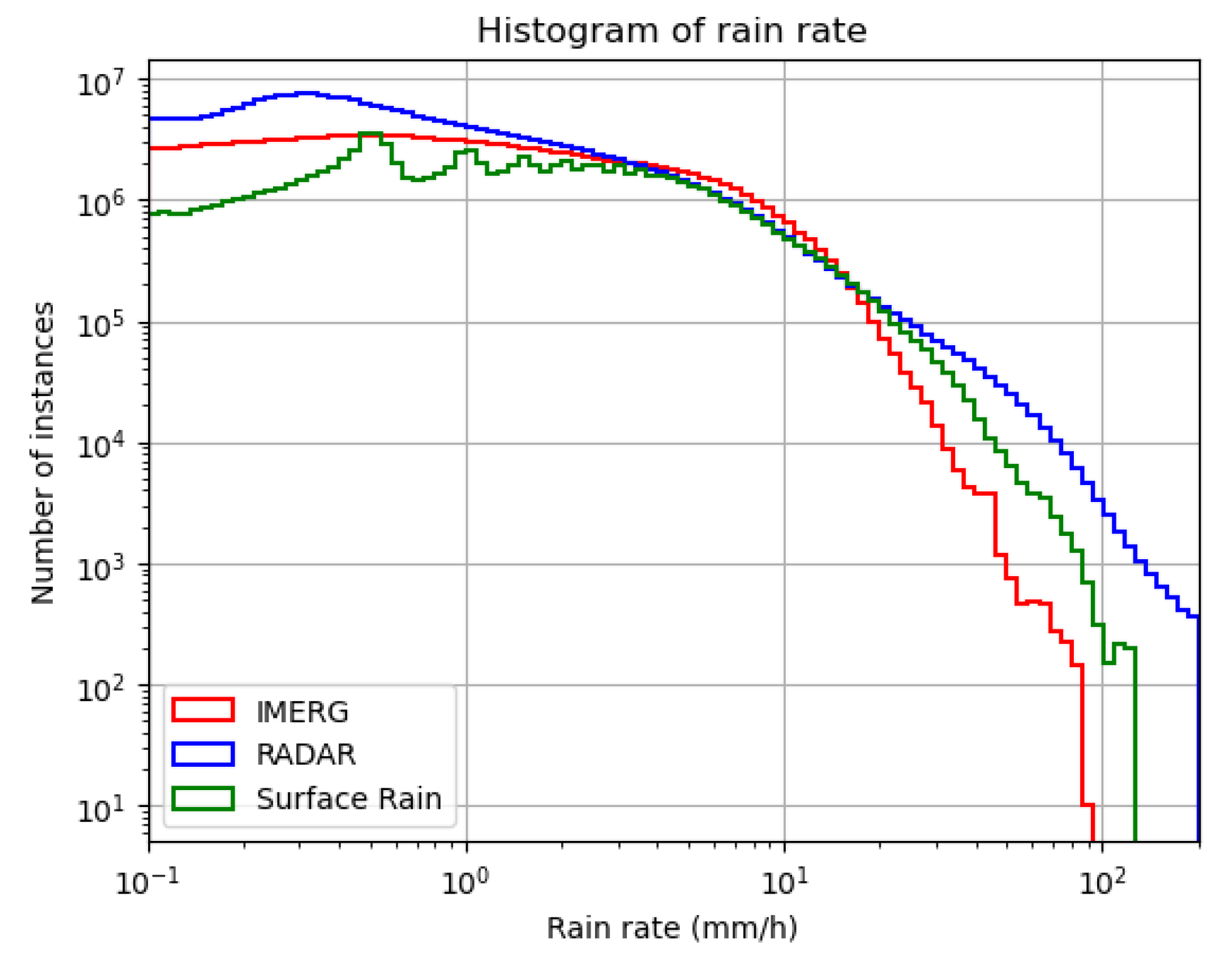
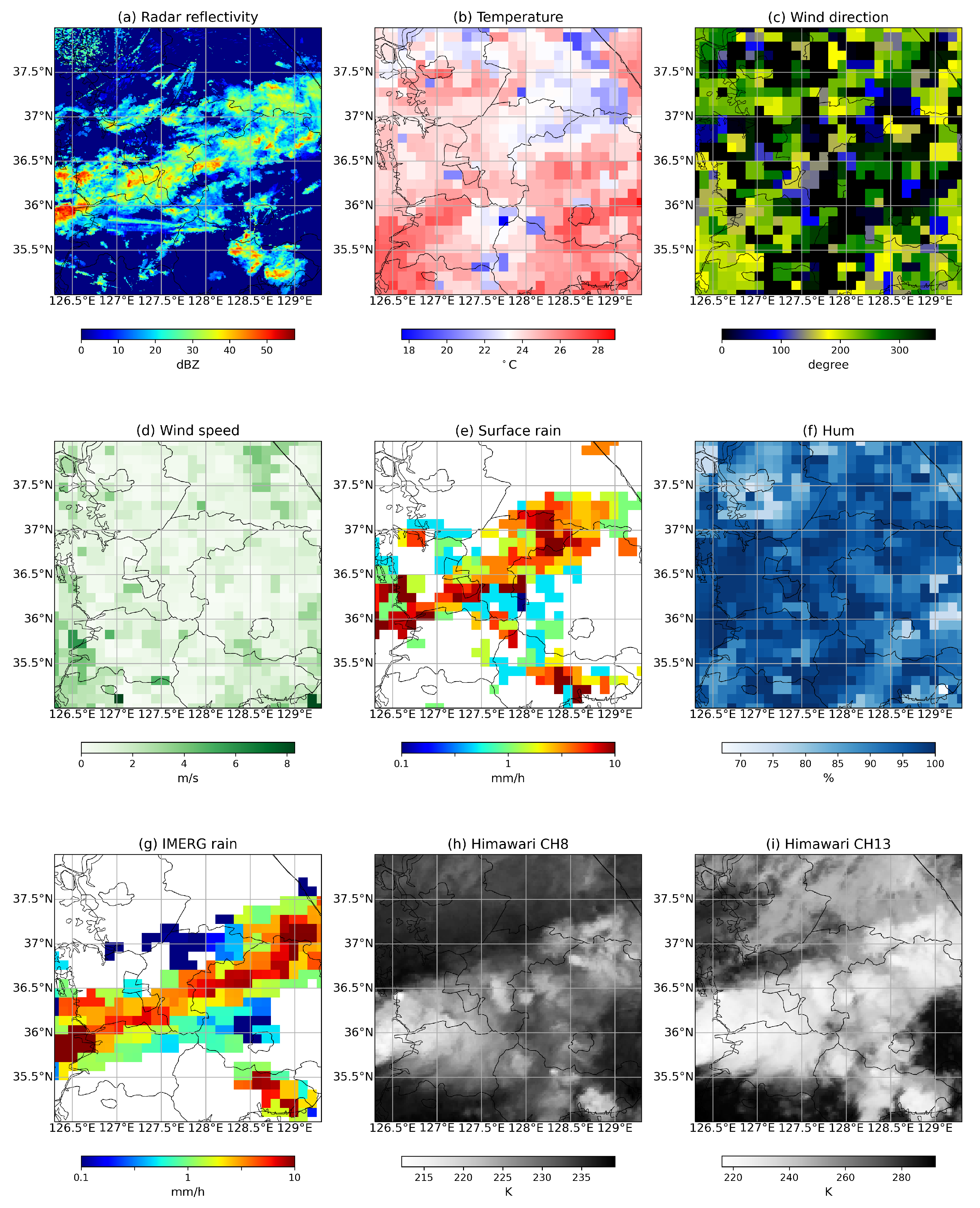

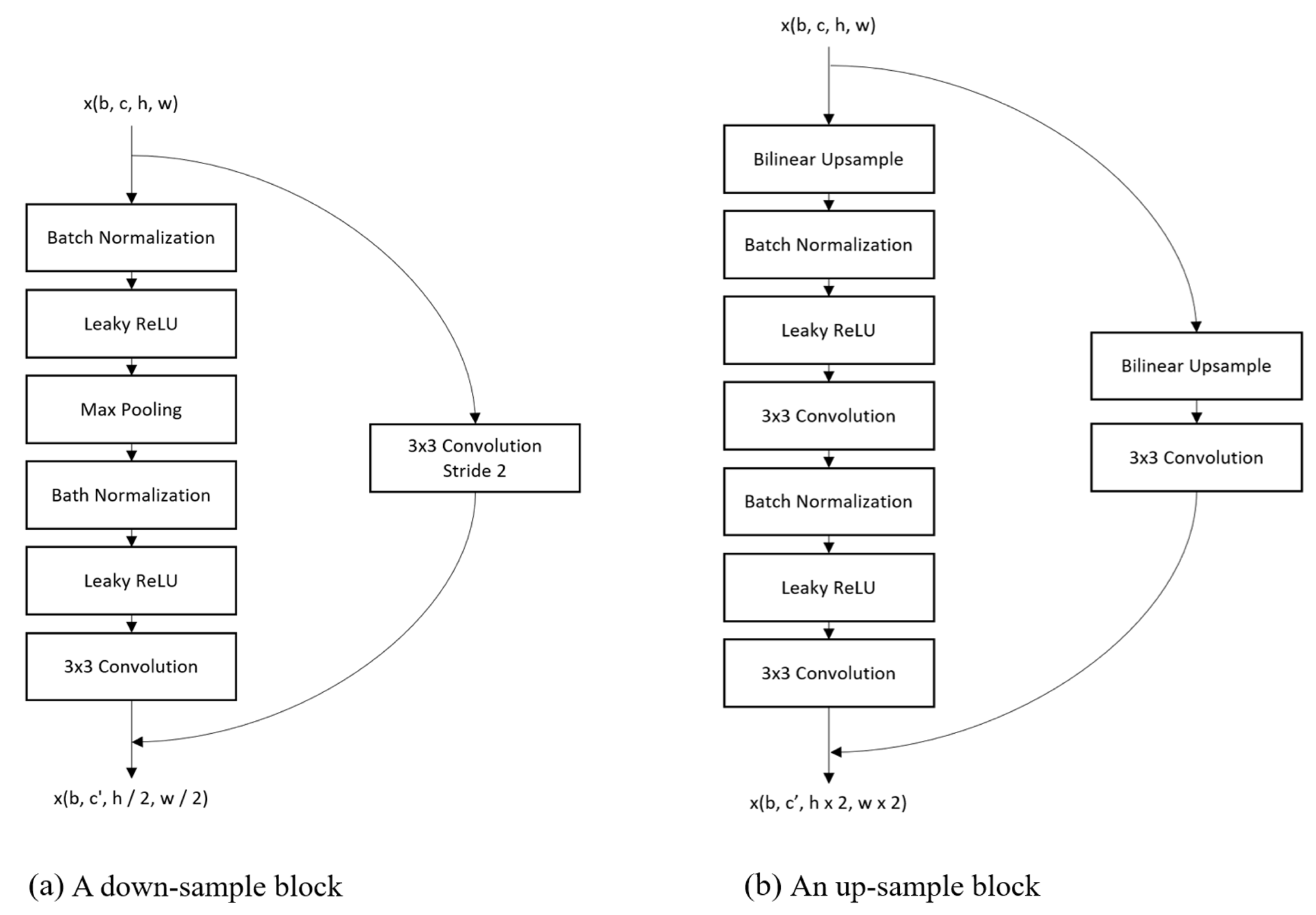
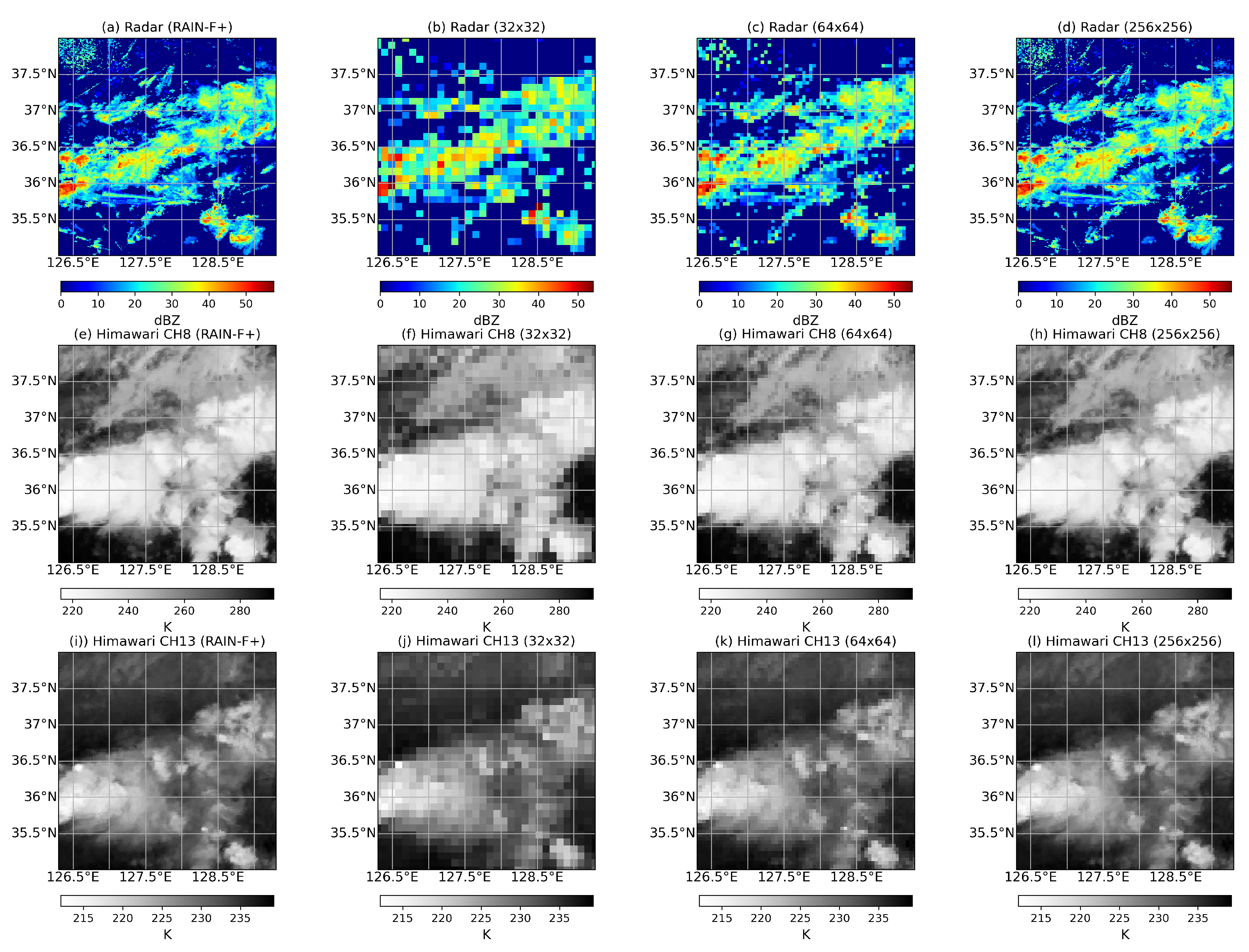

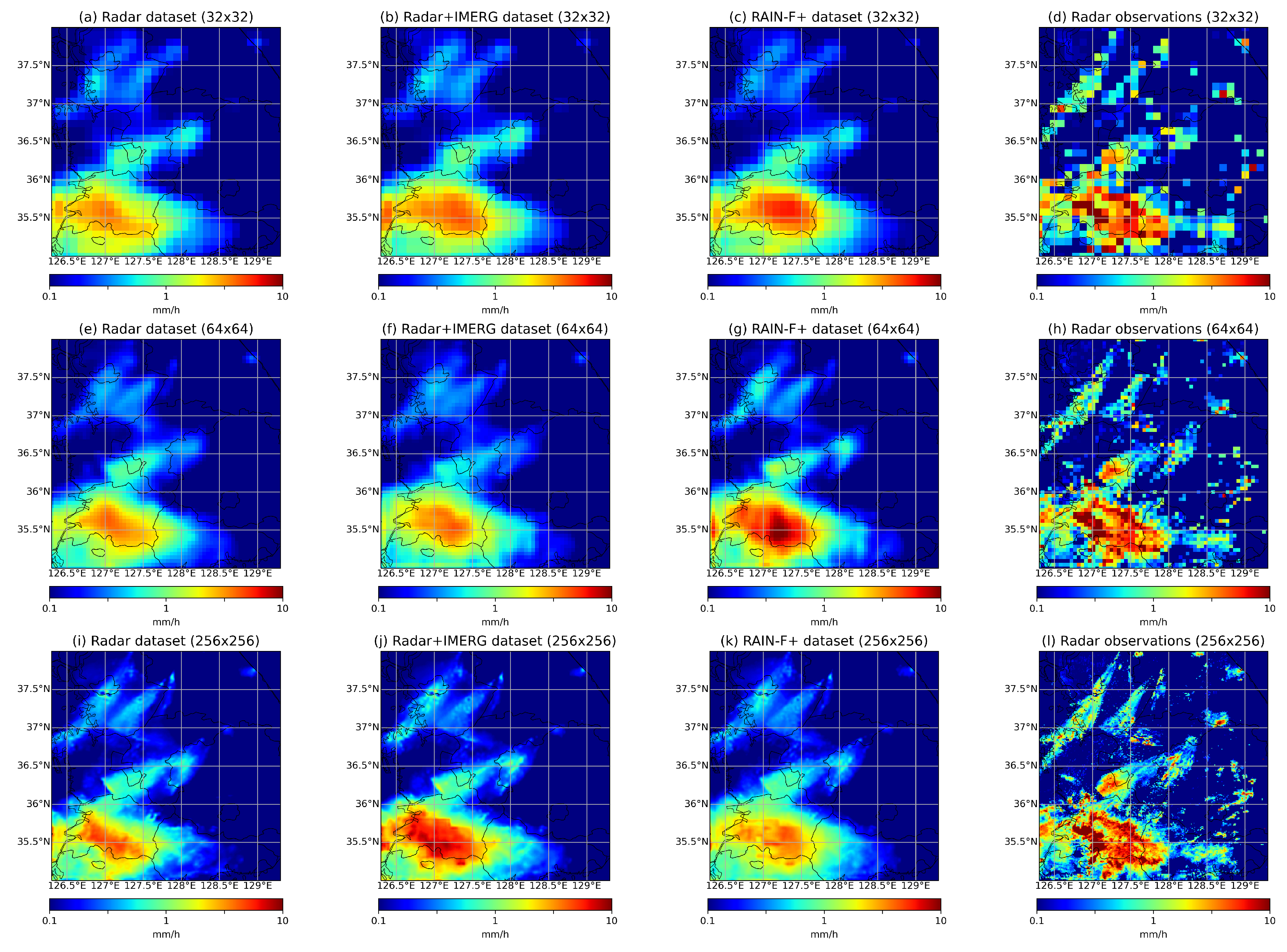
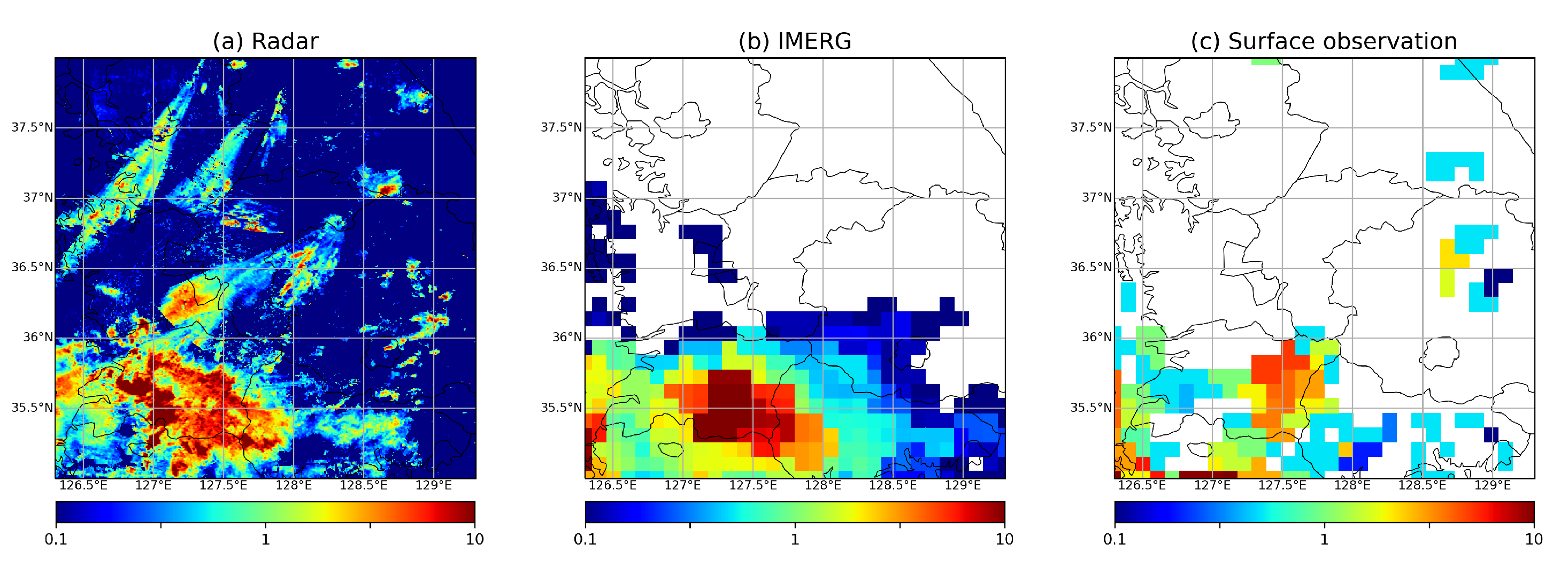

| Data Set | Greater than 0.1 | Greater than 1.0 | Greater than 5.0 | ||||||||
|---|---|---|---|---|---|---|---|---|---|---|---|
| MAE ↓ | ↑ | Precision | Recall ↑ | F1-Score ↑ | Precision ↑ | Recall ↑ | F1-Score ↑ | Precision ↑ | Recall ↑ | F1-Score ↑ | |
| Ra | 0.922 | 0.616 | 0.669 | 0.741 | 0.703 | 0.735 | 0.483 | 0.583 | 0.690 | 0.024 | 0.047 |
| Ra+Im | 0.907 | 0.627 | 0.660 | 0.742 | 0.699 | 0.709 | 0.534 | 0.609 | 0.538 | 0.131 | 0.211 |
| Ra+Sf | 0.930 | 0.617 | 0.649 | 0.757 | 0.699 | 0.747 | 0.468 | 0.576 | 0.687 | 0.011 | 0.021 |
| Ra+Hi | 0.907 | 0.622 | 0.665 | 0.746 | 0.703 | 0.733 | 0.502 | 0.596 | 0.701 | 0.054 | 0.100 |
| Ra+Im+Sf | 0.911 | 0.622 | 0.640 | 0.768 | 0.698 | 0.760 | 0.476 | 0.586 | 0.631 | 0.059 | 0.108 |
| Ra+Im+Hi | 0.920 | 0.624 | 0.680 | 0.732 | 0.705 | 0.777 | 0.449 | 0.569 | 0.610 | 0.053 | 0.098 |
| Ra+Sf+hi | 0.931 | 0.617 | 0.656 | 0.752 | 0.700 | 0.749 | 0.471 | 0.578 | 0.654 | 0.012 | 0.023 |
| RAIN-F+ | 0.914 | 0.621 | 0.647 | 0.762 | 0.700 | 0.763 | 0.477 | 0.587 | 0.627 | 0.035 | 0.066 |
| Data Set | Greater than 0.1 | Greater than 1.0 | Greater than 5.0 | ||||||||
|---|---|---|---|---|---|---|---|---|---|---|---|
| MAE ↓ | ↑ | Precision | Recall ↑ | F1-Score ↑ | Precision ↑ | Recall ↑ | F1-Score ↑ | Precision ↑ | Recall ↑ | F1-Score ↑ | |
| Ra | 0.910 | 0.629 | 0.675 | 0.737 | 0.704 | 0.749 | 0.485 | 0.589 | 0.664 | 0.045 | 0.085 |
| Ra+Im | 0.918 | 0.624 | 0.634 | 0.766 | 0.694 | 0.810 | 0.408 | 0.542 | 0.658 | 0.025 | 0.048 |
| Ra+Sf | 0.918 | 0.624 | 0.660 | 0.748 | 0.701 | 0.753 | 0.480 | 0.587 | 0.680 | 0.031 | 0.060 |
| Ra+Hi | 0.909 | 0.620 | 0.667 | 0.743 | 0.703 | 0.734 | 0.502 | 0.596 | 0.684 | 0.031 | 0.060 |
| Ra+Im+Sf | 0.910 | 0.624 | 0.645 | 0.760 | 0.697 | 0.740 | 0.500 | 0.597 | 0.502 | 0.116 | 0.189 |
| Ra+Im+Hi | 0.905 | 0.619 | 0.652 | 0.753 | 0.699 | 0.788 | 0.424 | 0.552 | 0.568 | 0.055 | 0.100 |
| Ra+Sf+hi | 0.931 | 0.615 | 0.659 | 0.750 | 0.702 | 0.711 | 0.535 | 0.610 | 0.658 | 0.036 | 0.068 |
| RAIN-F+ | 0.906 | 0.623 | 0.654 | 0.749 | 0.698 | 0.722 | 0.523 | 0.607 | 0.523 | 0.141 | 0.222 |
| Data Set | Greater than 0.1 | Greater than 1.0 | Greater than 5.0 | ||||||||
|---|---|---|---|---|---|---|---|---|---|---|---|
| MAE ↓ | ↑ | Precision | Recall ↑ | F1-Score ↑ | Precision ↑ | Recall ↑ | F1-Score ↑ | Precision ↑ | Recall ↑ | F1-Score ↑ | |
| Ra | 0.915 | 0.624 | 0.659 | 0.742 | 0.698 | 0.750 | 0.483 | 0.588 | 0.644 | 0.037 | 0.070 |
| Ra+Im | 0.905 | 0.620 | 0.660 | 0.745 | 0.700 | 0.750 | 0.502 | 0.602 | 0.661 | 0.041 | 0.077 |
| Ra+Sf | 0.904 | 0.622 | 0.664 | 0.737 | 0.699 | 0.703 | 0.539 | 0.610 | 0.590 | 0.108 | 0.183 |
| Ra+Hi | 0.928 | 0.618 | 0.665 | 0.737 | 0.700 | 0.762 | 0.475 | 0.585 | 0.640 | 0.003 | 0.006 |
| Ra+Im+Sf | 0.907 | 0.623 | 0.662 | 0.743 | 0.700 | 0.741 | 0.504 | 0.600 | 0.658 | 0.061 | 0.111 |
| Ra+Im+Hi | 0.910 | 0.630 | 0.688 | 0.721 | 0.704 | 0.737 | 0.518 | 0.608 | 0.325 | 0.018 | 0.035 |
| Ra+Sf+hi | 0.919 | 0.620 | 0.678 | 0.727 | 0.702 | 0.753 | 0.485 | 0.590 | 0.646 | 0.031 | 0.059 |
| RAIN-F+ | 0.908 | 0.630 | 0.655 | 0.746 | 0.698 | 0.773 | 0.476 | 0.589 | 0.571 | 0.083 | 0.145 |
Publisher’s Note: MDPI stays neutral with regard to jurisdictional claims in published maps and institutional affiliations. |
© 2021 by the authors. Licensee MDPI, Basel, Switzerland. This article is an open access article distributed under the terms and conditions of the Creative Commons Attribution (CC BY) license (https://creativecommons.org/licenses/by/4.0/).
Share and Cite
Choi, Y.; Cha, K.; Back, M.; Choi, H.; Jeon, T. RAIN-F+: The Data-Driven Precipitation Prediction Model for Integrated Weather Observations. Remote Sens. 2021, 13, 3627. https://doi.org/10.3390/rs13183627
Choi Y, Cha K, Back M, Choi H, Jeon T. RAIN-F+: The Data-Driven Precipitation Prediction Model for Integrated Weather Observations. Remote Sensing. 2021; 13(18):3627. https://doi.org/10.3390/rs13183627
Chicago/Turabian StyleChoi, Yeji, Keumgang Cha, Minyoung Back, Hyunguk Choi, and Taegyun Jeon. 2021. "RAIN-F+: The Data-Driven Precipitation Prediction Model for Integrated Weather Observations" Remote Sensing 13, no. 18: 3627. https://doi.org/10.3390/rs13183627
APA StyleChoi, Y., Cha, K., Back, M., Choi, H., & Jeon, T. (2021). RAIN-F+: The Data-Driven Precipitation Prediction Model for Integrated Weather Observations. Remote Sensing, 13(18), 3627. https://doi.org/10.3390/rs13183627





